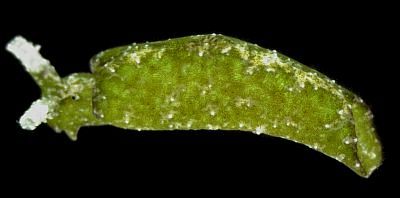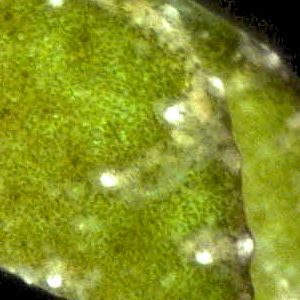

Elysia tuca
Marcus & Marcus, 1967
Order: SACOGLOSSA
Superfamily: ELYSIOIDEA
Family: Elysiidae
DISTRIBUTION
Caribbean, Florida to Brazil.
PHOTO
on Halimeda monile, west coast of Florida. Lower photo: enlarged view of part of parapodia. PHOTOS: Anna Bass.
The animals vary in colour from light to dark green and sometimes to brown. There is usually an opaque white patch on the head behind the rhinophores, and there is a white line from the patch running up the basal half of each rhinophore. Behind that there is another smaller white patch just anterior to the parapodia. There can be white patchng along the parapodial edge. The rhinophores have a white upper region, sometimes the upper half, while the lower half is often mottled with green or brown. The rhinophores often have prominent rounded papillae and there are also scattered papillae, often white on the parapodia. Grows to approx 20 mm long and is usually found feedng on species of the algal genus Halimeda.
In the parapodia there is an intricate network of branching digestive gland ducts [lower right photo] in which the choroplasts from its food are stored. E. tuca is one of the solar powered sacoglossans which keep the chloroplasts from their algal food alive and photosynthesising to produce sugars and other nutrients for their own use.
See Elysiella pusilla, a very similar-looking Halimeda feeder from the Indo-West Pacific.
-
Marcus, Ev. (1980) Review of western Atlantic Elysiidae (Opisthobranchia Ascoglossa) with a description of a new Elysia species. Bull. Mar. Sci. 30(1): 54-79.
-
Waugh, G.R., Clark, K.B. (1986) Seasonal and geographic variation in chlorophyll level of Elysia tuca (Ascoglossa: Opisthobranchia). Marine Biology, 92: 483-487.
Rudman, W.B., 2004 (February 18) Elysia tuca Marcus & Marcus, 1967. [In] Sea Slug Forum. Australian Museum, Sydney. Available from http://www.seaslugforum.net/find/elystuca
Related messages
Elysia tuca from Bermuda
September 7, 2007
From: Kimberly Holzer

Concerning message #20389:
Dear Bill,
Here is a picture of a sea slug that I found at one of my seagrass study sites in Bermuda. It was attached to a new leaf at the base of a Thalassia testudinum short shoot. Do you know what species it is?
Locality: Bailey's Bay, 2 m , Bermuda, Atlantic Ocean, 22 August 2007, Thalassia testudinum seagrass meadow. Length: 5-8 mm. Photographer: Kimberly Holzer.
Thanks in advance,
Kim
holzer@virginia.edu
Holzer, K.K., 2007 (Sep 7) Elysia tuca from Bermuda. [Message in] Sea Slug Forum. Australian Museum, Sydney. Available from http://www.seaslugforum.net/find/20626Dear Kim,
There are quite a few species of Elysia in the Caribbean and some of them, like species in the Indo-West Pacific, are quite difficult to tell apart. I am pretty sure this is Elysia tuca which is characterised in part by the white patch on the head with a white line going partly up each rhinophore. It is normally associated with Halimeda. Another species, Elysia serca, is usually found on sea grasses but it has a white patch on the edge of each parapodia, and is rather different in shape from your animal, so I suspect your finding of it on Thalassia may have no biological significance.
Best wishes,
Bill Rudman
Elysia tuca from the Bahamas
September 12, 2005
From: Anne DuPont


Dear Bill,
I found this Elysia tuca in the same way that I found the other Elysia species [Aug 27 posting #14645]. I found it "munching away" on damaged Halimeda incrassata. This photo shows the white on the rhinophores, and the color markings that are similar to the Elysia species.
Location: Stocking Island, Exumas Bahamas, 7 feet of water, January 14, 2005, Size approximately 15 mm.
Thank you,
Anne DuPont
Delray Beach, Fl
akduont@bellsouth.net
DuPont, A., 2005 (Sep 12) Elysia tuca from the Bahamas. [Message in] Sea Slug Forum. Australian Museum, Sydney. Available from http://www.seaslugforum.net/find/14654
Dear Anne,
Thanks for the comparision. Every time I see this animal I think of the cylindrical form of Elysiella pusilla from the Indo-West Pacific which looks almost identical.
Best wishes,
Bill Rudman
Elysia tuca with parasite
February 21, 2004
From: Marina Poddubetskaia

Dear Bill,
One of these specimens of Elysia tuca had a strange thing between its parapodia. Are these the copepod's eggs ?
Date: February 05, 2004
Location: Great Exuma, Bahamas, Western Atlantic
Site: Stocking Island, Hole n°0
Depth: 1m
Size: 7mm
Photos: Marina Poddubetskaia - Nembro website
Cordially,
Marina.
nembro@nembro.info


Thanks Marina,
Yes these are copepod eggs. From the relative size of them I suspect they belong to quite a large copepod which burrows into the body of the Elysia. I have seen a dorid nudibranch wit 5 or 6 copepods buried into the sac around the heart [pericardium], with the egg masses sticking out amongst the gills. From the position of these egg masses I wouldn't be surprised if the copepod was in a similar position in this animal. Erwin Koehler's photo of Risbecia tryoni, [#4959], shows a single animal in the same place.
Best wishes
Bill Rudman
Elysia tuca from Southern Bahamas
February 20, 2004
From: Marina Poddubetskaia

Dear Bill,
Recently, I spent one week with Anne DuPont diving and snorkelling in the Southern Bahamas. Anne's boat is anchored near Stocking Island (Exuma) and we've found there a lot of cephalaspideans (already contributed to the Forum by Anne) and many Elysia species.
Little by little I will send you different photos and Anne could complete them on her come back from the Bahamas.
So, I will start with this sacoglossan which I think to be Elysia tuca. I'd like to have your opinion on my ID, please. This species seems quite common near Stocking Island. The first specimen is the largest of all I've seen there. I found it on the seaweed, just like in the photo. Other specimens were found on a specific alga (see attached photo). In the Hole n°0 I saw a lot of this algae invaded by this Elysia. So, I expect it is its food.
Upper & Lower Right: Great Exuma, Bahamas, Western Atlantic. Site: Stocking Island, Hole n°2. Depth: 4.5m. February 01, 2004. Size: 18-20mm
Lower Left: Great Exuma, Bahamas, Western Atlantic. Site: Stocking Island, Hole n°0. Depth: 1m. February 05, 2004. Size: 13-15mm.
Photos: Marina Poddubetskaia - Nembro website
Thank you in advance for your help.
Best wishes,
Marina (and Anne).
nembro@nembro.info



Dear Marina,
I look forward to photos of Caribbean sacoglossans. There have nbeen a lot of names given to species of Elysia but its not easy to identify them from the published descriptions which often have very poor descriptions of their external features.
I agree that this is Elysia tuca. It looks remarkably similar to the narrow form of Elysiella pusilla, an Indo-Pacific species which also feeds on algae of the genus Halimeda, which your species also does. I have included one of your photos of the algae alongside.
Best wishes
Bill Rudman
Elysia tuca from west coast of Florida
April 28, 2001
From: Anna L. Bass

Hey,
Thought you might could use this photo of Elysia tuca. The animal was collected on Halimeda monile. I'm not sure of the water depth, but it was in a sea grass bed. Probably not deeper than 2m. The individual is 10mm in length.
Regards,
Anna
abass@helios.acomp.usf.edu
Bass, A.L., 2001 (Apr 28) Elysia tuca from west coast of Florida. [Message in] Sea Slug Forum. Australian Museum, Sydney. Available from http://www.seaslugforum.net/find/4240
Thanks Anna,
I have included alongside an enlarged view of your photo to show part of the parapodia and the intricate network of branching digestive gland ducts in which the choroplasts from its algal food are stored. To those of you unfamilar with these animals, E. tuca is one of the solar powered sacoglossans which keeps the chloroplasts from its algal food alive in its body and uses the sugars and other nutrients produced by photosynthesis for it own use.
Waugh, GR; Clark, KB (1986): Seasonal and geographic variation in chlorophyll level of Elysia tuca (Ascoglossa: Opisthobranchia). Marine Biology, 92: 483-487.
Thanks again Anna for a photo of another relatively common animal which is quite unknown to most of us.
Best wishes,
Bill Rudman
Chemoreception in Elysia tuca
June 17, 1999
From: Charlie Hileman
Hello!
I am working this summer in the offshore mangroves of Key Largo, Florida, looking at the chemoreception of the sacoglossan Elysia tuca. I've used several techniques, but have been unable to construct a Y- or T-maze that works well for these sly sea slugs. Does someone have some experience in this field that could me some suggestions? Is a Y-maze better than a T-maze? What type of design would induce them best to make the trip up the maze?
Please forward any responses to my email address. Many thanks.
Charlie Hileman
Department of Marine Science
UNC,
Chapel Hill
Summer research in Florida: 305-852-7237
chileman@email.unc.edu
Dear Charlie,
Hopefully someone visiting the Forum can help you. You don't mention whether your other experiments have shown any evidence of distance chemoreception. Perhaps the T and Y mazes you have constructed are well-designed but don't work because Elysia tuca doesn't have the ability to detect the waterborne molecules you are testing it for.
Some background information on your research would be of great interest. If you have a photo of Elysia tuca it would be nice to include it with your message.
Best wishes,
Bill Rudman.
